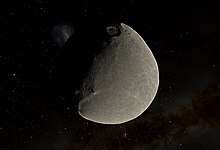2010 TJ
2010 TJ is a trans-Neptunian object from the scattered disc in the outermost region of the Solar System and measures approximately 460 kilometers in diameter. It was first observed by American astronomers David Rabinowitz, Megan Schwamb, and Suzanne Tourtellotte at ESO's La Silla Observatory in northern Chile on 2 October 2010.[4]
| Discovery [1][2] | |
|---|---|
| Discovered by | D. L. Rabinowitz M. E. Schwamb S. Tourtellotte |
| Discovery site | La Silla Obs. |
| Discovery date | 2 October 2010 (first observed only) |
| Designations | |
| 2010 TJ | |
| TNO [1] · SDO [3] distant [4] | |
| Orbital characteristics [1] | |
| Epoch 4 September 2017 (JD 2458000.5) | |
| Uncertainty parameter 4 | |
| Observation arc | 7.22 yr (2,636 days) |
| Aphelion | 84.870 AU |
| Perihelion | 39.894 AU |
| 62.382 AU | |
| Eccentricity | 0.3605 |
| 492.72 yr (179,965 d) | |
| 12.366° | |
| 0° 0m 7.2s / day | |
| Inclination | 38.931° |
| 91.226° | |
| 273.70° | |
| Physical characteristics | |
Mean diameter | 443 km (estimated)[3] 471 km (assumed)[5] |
| 0.07 (assumed)[5] 0.09 (assumed)[3] | |
| 5.0[1] · 5.3[5] | |
Orbit and classification
2010 TJ is a probably a dwarf planet, based on Michael Brown's classification.[5] Typical for scattered disc objects,[3] it has an elliptical and inclined orbit: the object orbits the Sun at a distance of 39.9–84.9 AU once every 492 years and 9 months (179,965 days; semi-major axis of 62.4 AU). Its orbit has an eccentricity of 0.36 and an inclination of 39° with respect to the ecliptic.[1] The body's observation arc begins with its first observation at La Silla in October 2010.[4]
Physical characteristics

2010 TJ's color and taxonomic type have not yet been determined.[1][3]
Rotation period
As of 2018, no rotational lightcurve of 2010 TJ has been obtained from photometric observations. The object's rotation period, shape and poles remain unknown.[6]
Numbering and naming
This minor planet has neither been numbered nor named.[4]
References
- "JPL Small-Body Database Browser: (2010 TJ)" (2017-12-20 last obs.). Jet Propulsion Laboratory. Retrieved 17 January 2018.
- "List Of Centaurs and Scattered-Disk Objects". Minor Planet Center. Retrieved 17 January 2018.
- Johnston, Wm. Robert (15 October 2017). "List of Known Trans-Neptunian Objects". Johnston's Archive. Retrieved 17 January 2018.
- "2010 TJ". Minor Planet Center. Retrieved 17 January 2018.
- Michael E. Brown. "How many dwarf planets are there in the outer solar system?". California Institute of Technology. Retrieved 17 January 2018.
- "LCDB Data for (2010 TJ)". Asteroid Lightcurve Database (LCDB). Retrieved 17 January 2018.
External links
- Asteroid Lightcurve Database (LCDB), query form (info)
- 2010 TJ at AstDyS-2, Asteroids—Dynamic Site
- 2010 TJ at the JPL Small-Body Database
_(cropped).jpg)
